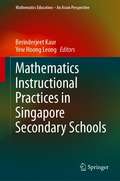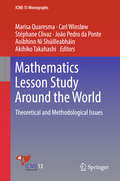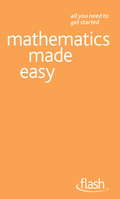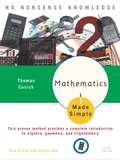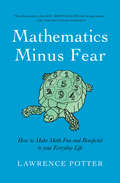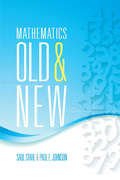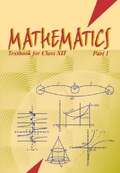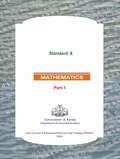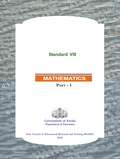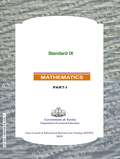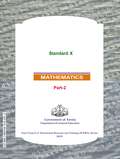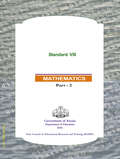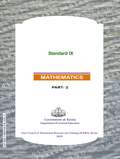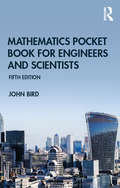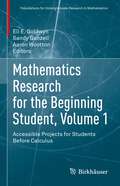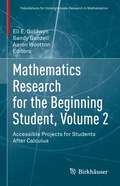- Table View
- List View
Mathematics Instructional Practices in Singapore Secondary Schools (Mathematics Education – An Asian Perspective)
by Berinderjeet Kaur Yew Hoong LeongThis book offers a detailed look into the how and what of mathematics instruction in Singapore. It presents multiple aspects of mathematics instruction in schools, ranging from the unique instructional core, practices that promote mastery, development of conceptual knowledge through learning experiences, nurturing of positive attitudes, self-regulation of learning and development and use of instructional materials for making connections across mathematical ideas, developing mathematical reasoning, and developing fluency in applying mathematical knowledge in problem solving.The book presents a methodology that is successful in documenting classroom instruction in a comprehensive manner. The research findings illuminate instruction methods that are culturally situated, robust and proven to impact student learning. It demonstrates how a unique data source can be analysed through multiple lenses and provides readers with a rich portrait of how the school mathematics instruction is enacted in Singapore secondary schools.
Mathematics Lesson Study Around the World: Theoretical And Methodological Issues (ICME-13 Monographs)
by João Pedro da Ponte Marisa Quaresma Carl Winsløw Stéphane Clivaz Aoibhinn Ní Shúilleabháin Akihiko TakahashiThis book introduces the specifics of mathematics lesson study with regard to regional/national particularities, discussing the methodological and theoretical tools that can be used to pursue research on lesson study (its forms, contents, effects etc.) from an international perspective. Lesson study and learning study (LS) are becoming increasingly important in teacher education, mostly in continuous professional development, but also in prospective teachers’ education, and this interest is accompanied by a demand for more solid theorization of the lesson study process. A number of social, cultural, cognitive and affective issues are reflected in the way LS develops, and the book examines the latest results of these developments.
Mathematics Made Easy: Flash
by Trevor Johnson Hugh NeilThe books in this bite-sized new series contain no complicated techniques or tricky materials, making them ideal for the busy, the time-pressured or the merely curious. Mathematics Made Easy is a short, simple and to-the-point guide to mathematics. In just 96 pages, the reader will learn all the basics, from addition and subtraction to fractions and decimals. Ideal for the busy, the time-pressured or the merely curious, Mathematics Made Easy is a quick, no-effort way to break into this fascinating topic.
Mathematics Made Easy: Flash
by Trevor Johnson Hugh NeilThe books in this bite-sized new series contain no complicated techniques or tricky materials, making them ideal for the busy, the time-pressured or the merely curious. Mathematics Made Easy is a short, simple and to-the-point guide to mathematics. In just 96 pages, the reader will learn all the basics, from addition and subtraction to fractions and decimals. Ideal for the busy, the time-pressured or the merely curious, Mathematics Made Easy is a quick, no-effort way to break into this fascinating topic.
Mathematics Made Simple (Sixth Edition)
by Thomas CusickThis book serves as a review of arithmetic, and an introduction to algebra, geometry, and trigonometry and probability.The exercises and answers in this book provide readers with opportunities to test their mastery of each topic in these common branches of mathematics.
Mathematics Minus Fear: How to Make Math Fun and Beneficial to Your Everyday Life
by Lawrence PotterForget your classroom nightmares and discover how numbers can enhance and illuminate your world!How can math help you bet on horses or win in Vegas? What's the foolproof way to solve Sudoku? How can probability teach you to calculate your chances of survival in Russian roulette?In this irreverent and entertaining guide to mathematics, Lawrence Potter takes the fear out of everything from long division to percentages. Using fascinating puzzles and surprising examples, he shows us how math is connected with the world we encounter every day, from how the VAT works to why weather forecasts are wrong, from winning at Monopoly to improving your mental arithmetic. Along the way you'll also discover who invented numbers, whether animals can count, and what nuns have to do with multiplication.
Mathematics Minus Fear: How to Make Math Fun and Beneficial to Your Everyday Life
by Lawrence PotterForget your classroom nightmares and discover how numbers can enhance and illuminate your world!How can math help you bet on horses or win in Vegas? What&’s the foolproof way to solve Sudoku? How can probability teach you to calculate your chances of survival in Russian roulette? In this irreverent and entertaining guide to mathematics, Lawrence Potter takes the fear out of everything from long division to percentages. Using fascinating puzzles and surprising examples, from M.C. Escher to Pascal, he shows us how math is connected with the world we encounter every day, from how the VAT works to why weather forecasts are wrong, from winning at Monopoly to improving your mental arithmetic. Along the way you&’ll also discover who invented numbers, whether animals can count, and what nuns have to do with multiplication.
Mathematics Old and New
by Paul E. Johnson Saul StahlThis introductory treatment provides insightful expositions of specific applications as well as elements of mathematical history and culture. The in-depth coverage of key mathematical topics is presented in clear terms and at an informal level that relates classic concepts to readers' everyday lives. Some knowledge of high school algebra would be useful for a full appreciation of the book, which is suitable for advanced high school students and college undergraduates in all fields as well as readers with an interest in mathematics and its history. The first five chapters, as published in the book's first edition, deal somewhat unconventionally with probability, statistics, voting systems, game theory, and linear programming. This new edition adds chapters on geometry in two and three dimensions, Egyptian arithmetic, the evolution of the normal distribution, and other subjects. Readers are certain to acquire a heightened awareness of many aspects of contemporary mathematics and its subject matter, relevant applications, and history.
Mathematics Part 1 Class 12 NCERT
by National Council of Educational Research and TrainingNCERT designed the new syllabi and constituted Textbook Development Teams for Classes XI and XII to prepare textbooks in mathematics under the new guidelines and new syllabi.
Mathematics Part 1 class 10 - S.C.E.R.T. - Kerala Board
by State Council of Educational Research TrainingMathematics Part 1 textbook for 10th standard from State Council of Educational Research and Training (S.C.E.R.T.) Kerala in English.
Mathematics Part 1 class 12 - Meghalaya Board
by Meghalaya Board of School EducationMeghalaya board of school education designed the new syllabi and constituted Textbook Development Teams for Classes XI and XII to prepare textbooks in mathematics under the new guidelines and new syllabi.
Mathematics Part 1 class 5 - Kerala Board
by ScertMathematics text book, class V, SCERT Kerala syllabus, english medium. It covers the chapters - Number World, When Lines Join, Equal Sharing, Circles and Part Number.
Mathematics Part 1 class 8 - S.C.E.R.T. - Kerala Board
by State Council of Educational Research TrainingMathematics Part 1 textbook for 8th standard from State Council of Educational Research and Training (S.C.E.R.T.) Kerala in English.
Mathematics Part 1 class 9 - S.C.E.R.T. - Kerala Board
by State Council of Educational Research TrainingMathematics Part 1 textbook for 9th standard from State Council of Educational Research and Training (S.C.E.R.T.) Kerala in English.
Mathematics Part 2 class 10 - S.C.E.R.T. - Kerala Board
by State Council of Educational Research TrainingMathematics Part 2 textbook for 10th standard from State Council of Educational Research and Training (S.C.E.R.T.) Kerala in English.
Mathematics Part 2 class 12 - Meghalaya Board
by Meghalaya Board of School EducationMeghalaya Board of School Education designed the new syllabi and constituted Textbook Development Teams for Classes XI and XII to prepare textbooks in mathematics under the new guidelines and new syllabi.
Mathematics Part 2 class 5 - Kerala Board
by ScertMathematics text book, class V, SCERT Kerala syllabus, english medium. It covers the chapters - Area, Inside Numbers, Joining Parts and Let's Read Pictures.
Mathematics Part 2 class 8 - S.C.E.R.T. - Kerala Board
by State Council of Educational Research TrainingMathematics Part 2 textbook for 8th standard from State Council of Educational Research and Training (S.C.E.R.T.) Kerala in English.
Mathematics Part 2 class 9 - S.C.E.R.T. - Kerala Board
by State Council of Educational Research TrainingMathematics Part 2 textbook for 9th standard from State Council of Educational Research and Training (S.C.E.R.T.) Kerala in English.
Mathematics Part-1 class 12 - NCERT - 23
by National Council of Educational Research and TrainingThe NCERT developed the new textbook for Class XII Mathematics following a rigorous process. It involved a team of NCERT faculty, experts, and practicing teachers who prepared the initial draft. The draft was refined through meetings and feedback from practicing teachers across the country. An editorial board finalized the draft, which was then approved by the Advisory Group in Science and Mathematics and the Monitoring Committee of the HRD Ministry. The textbook features chapters with introductions, organized sections, proofs, visualizations, applications, examples, and exercises. It also includes historical backgrounds, quotations, photographs, and summaries for better understanding.
Mathematics Pocket Book for Engineers and Scientists (Routledge Pocket Books)
by John BirdThis compendium of essential formulae, definitions, tables and general information provides the mathematical information required by engineering students, technicians, scientists and professionals in day-to-day engineering practice. A practical and versatile reference source, now in its fifth edition, the layout has been changed and streamlined to ensure the information is even more quickly and readily available – making it a handy companion on-site, in the office as well as for academic study. It also acts as a practical revision guide for those undertaking degree courses in engineering and science, and for BTEC Nationals, Higher Nationals and NVQs, where mathematics is an underpinning requirement of the course. All the essentials of engineering mathematics – from algebra, geometry and trigonometry to logic circuits, differential equations and probability – are covered, with clear and succinct explanations and illustrated with over 300 line drawings and 500 worked examples based in real-world application. The emphasis throughout the book is on providing the practical tools needed to solve mathematical problems quickly and efficiently in engineering contexts. John Bird’s presentation of this core material puts all the answers at your fingertips.
Mathematics Practice and Problem Solving [Grade] 3 (Ready North Carolina)
by Sarah Kraus David PolakoffNIMAC-sourced textbook
Mathematics Research for the Beginning Student, Volume 1: Accessible Projects for Students Before Calculus (Foundations for Undergraduate Research in Mathematics)
by Aaron Wootton Eli E. Goldwyn Sandy GanzellMathematics research opportunities for undergraduate students have grown significantly in recent years, but accessible research topics for first- and second-year students with minimal experience beyond high school mathematics are still hard to find. To address this need, this volume provides beginning students with specific research projects and the tools required to tackle them. Most of these projects are accessible to students who have not yet taken Calculus, but students who know some Calculus will find plenty to do here as well. Chapters are self-contained, presenting projects students can pursue, along with essential background material and suggestions for further reading. Suggested prerequisites are noted at the beginning of each chapter. Some topics covered include:games on graphsmodeling of biological systemsmosaics and virtual knotsmathematics for sustainable humanitymathematical epidemiologyMathematics Research for the Beginning Student, Volume 1 will appeal to undergraduate students at two- and four-year colleges who are interested in pursuing mathematics research projects. Faculty members interested in serving as advisors to these students will find ideas and guidance as well. This volume will also be of interest to advanced high school students interested in exploring mathematics research for the first time. A separate volume with research projects for students who have already studied calculus is also available.
Mathematics Research for the Beginning Student, Volume 2: Accessible Projects for Students After Calculus (Foundations for Undergraduate Research in Mathematics)
by Aaron Wootton Eli E. Goldwyn Sandy GanzellMathematics research opportunities for undergraduate students have grown significantly in recent years, but accessible research topics for first- and second-year students are still hard to find. To address this need, this volume provides beginning students who have already had some exposure to calculus with specific research projects and the tools required to tackle them. Chapters are self-contained, presenting projects students can pursue, along with essential background material and suggestions for further reading. In addition to calculus, some of the later chapters require prerequisites such as linear algebra and statistics. Suggested prerequisites are noted at the beginning of each chapter. Some topics covered include:lattice walks in the planestatistical modeling of survival databuilding blocks and geometrymodeling of weather and climate changemathematics of risk and insuranceMathematics Research for the Beginning Student, Volume 2 will appeal to undergraduate students at two- and four-year colleges who are interested in pursuing mathematics research projects. Faculty members interested in serving as advisors to these students will find ideas and guidance as well. This volume will also be of interest to advanced high school students interested in exploring mathematics research for the first time. A separate volume with research projects for students who have not yet studied calculus is also available.
